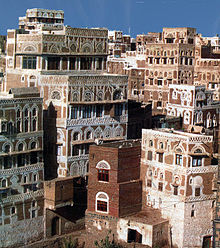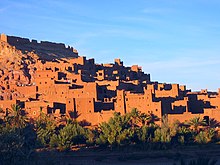Rammed earth


The rammed earth (or "pisé" of French Piser , German , stomp ' , Spanish pisar ; English rammed earth ) is a massive clay building -Art and differs fundamentally from the building with air-dried mud bricks .
In addition to walls, floors were also made from rammed earth.
history
Already in the pre-ceramic Neolithic z. B. built in Jarmo rammed earth buildings. The technique was used in the Berber regions of North Africa , on the Arabian Peninsula and in the Near East (baptism) , where it is still in use today in rural areas, even if it is becoming rarer. Even in large parts of Europe, rammed earth was used for building well into the Middle Ages; In modern times, building with clay was gradually forgotten - clay blocks and burnt bricks replaced rammed earth walls . It was not until the end of the 18th century that the technology was resumed in the form of the "clay pisé construction" that was widespread in Switzerland and France.
In Thuringia and Saxony in particular , the clay corrugated construction method was developed , in which the clay is not tamped into the formwork, but can be built up directly to form a wall due to the higher proportion of straw , the surfaces of which are later cut off smooth.
Similar to rammed earth, lime-sand mixtures and cement-sand mixtures were later used to produce tamped floors. See: stamped concrete
processing
Depending on the region, layers approx. 10–40 cm high (with higher layers no good compaction is possible) of earth-moist loam with a bulk density of 1700 to 2200 kg / m³ are poured between pressure-resistant formwork and compacted by stepping on or working with rammers. Machine tamping reduces the time and effort required compared to traditional techniques. After completion, it can be switched off immediately because - unlike with concrete - there is no setting time . However, entering a sentence that has just been switched off should be avoided at first.
In the case of a rammed earth wall stiffened by the supporting structure of the building, the wall thickness should be at least one twelfth of the height. A free-standing wall has to be wider.
Advantages and disadvantages
The clay and marl mixtures that are often found in nature can easily be made usable for rammed earth construction by adding clay, sand, gravel and straw . Rammed earth is one of the most environmentally friendly building materials of all, since only a comparatively small amount of primary energy is required for extraction, transport and mixing . In contrast to building materials such as concrete , burned or steamed artificial stone or steel, the consumption of resources is limited to a minimum.
In addition, clay is hygroscopic , i.e. it absorbs (air) moisture and releases it again, and thus, like open-pored wood and other natural building materials, has a beneficial effect on the room climate. Clay can absorb allergenic or otherwise harmful substances from indoor air.
If the building is demolished or converted, the building material can be stored until it is mixed with water again and used again or returned to the landscape from which it was removed.
As was common in earlier centuries, the thermal insulation value of the building material can be greatly improved by adding fiber materials such as straw, wood wool, wood chips, chips, sawdust or light mineral fillers such as expanded clay , expanded slate , perlite and the like. A solid rammed earth wall reaches the F90 standard . In multi-storey buildings, it must be checked whether the fire brigade's extinguishing water could soften unprotected, load-bearing walls and impair the stability.
Clay is less resistant to moisture penetration as well as compressive, tensile and bending stresses than other building materials, which sets limits on building designs with filigree or protruding components. Otherwise, clay is a structurally sufficiently solid, inexpensive building material.
Surface structure
There are different tones of clay. The wall can be colored by adding earth pigments .
The surface structure of unplastered rammed earth is of course also influenced by the aggregates and the processing. As a rule, it can be expected that the steps created by the introduction of the clay mixture in layers into the formwork will later be visible as lines.
See also
literature
- Solomon Sachs : Instructions for earthworks art (Pisé construction) . Verlag der Buchhandlung Friederich Amelang, Berlin 1825. (digitized version)
- Richard Niemeyer: Earth building and its practical application . Unchanged reprint of the original edition from 1946. Ökobuch Verlag, Staufen near Freiburg 1982, ISBN 3-922964-10-9 .
- Martin Rauch: Rammed Earth (= clay and architecture ). Birkhäuser, Basel et al. 2001, ISBN 3-7643-6461-0 .
- Günter zur Nieden, Christof Ziegert: New clay houses internationally. Project examples, constructions, details . Bauwerk, Berlin 2002, ISBN 3-934369-11-1 .
- Silke Krüger: Rammed earth. Renaissance of an ancient technique . Manudom-Verlag, Aachen 2004, ISBN 3-9807245-1-4 .
- Peter Walker, Rowland Keable, Joe Martin, Vasilios Maniatidis: Rammed Earth. Design and construction guidelines . BRE Bookshop, Watford 2005, ISBN 1-86081-734-3 (Pub. No. EP 62).
- Ulrich Röhlen, Franz Volhard: Earth building rules. Terms - building materials - components. 3rd, revised edition. Vieweg + Teubner Verlag, Wiesbaden 2009, ISBN 978-3-8348-0189-0 (practice) .
- Ulrich Röhlen, Christof Ziegert: Earth building practice. Planning and execution. Bauwerk, Berlin 2010, ISBN 978-3-89932-125-8 .
Web links
Footnotes
- ^ Marcus Casutt: Swiss school buildings in the Pisébau. Thurgauer Jahrbuch, accessed on April 26, 2020 .
- ↑ Georg Maybaum: Structural behavior of non-reinforced rammed earth walls and their strengthening. In: Dachverband Lehm eV, conference contributions of the 6th International Conference on Earth Building / 6th International Conference on Building with Earth, Weimar, 5. – 7. October 2012, ISBN 978-3-00-039649-6 , pp. 54 and pp. 278–281.


